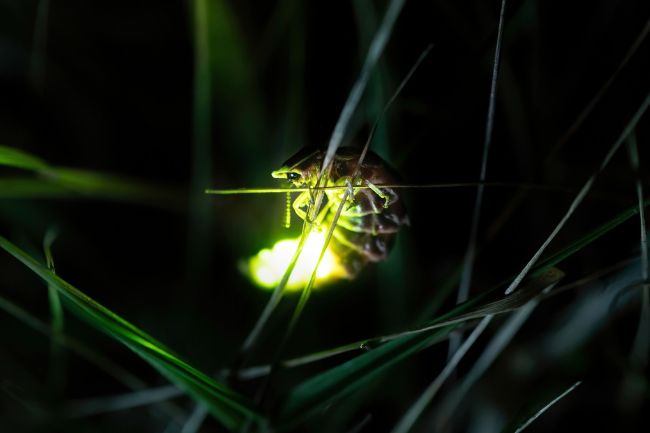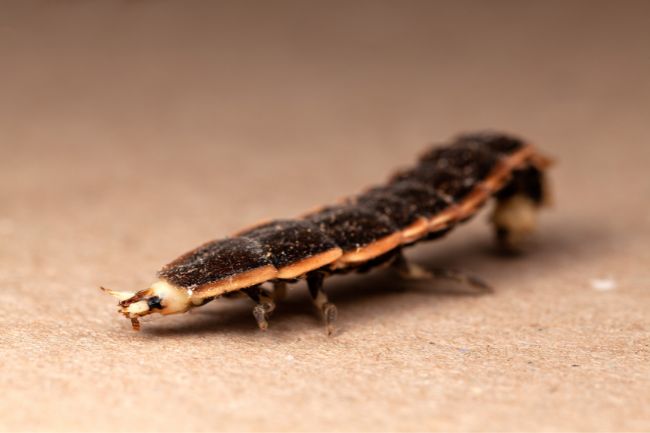Fireflies are a type of beetle, and like all beetles they start their life as a larva that hatches from an egg. The larvae spend their time hunting tasty slugs and snails until the day they become an adult.
Contents
What are fireflies?

Fireflies are a type of beetle that uses bioluminescence both as a warning signal to predators and to attract a mate. There are around 2,000 species of fireflies across the world, found mostly in temperate and tropical regions, such as areas of North America, Europe and Asia.
Most fireflies live within damp habitats, usually grasslands, the edges of rivers and lakes, or woodland fringes. Their diet can vary a great deal, though many species rely on soft-bodied invertebrates as their main food source as larvae, and a mixture of pollen, nectar, and small invertebrates as adults.
The glow emitted by fireflies varies between species. Some species only glow as larvae, others as adults and larvae, and a few species do not glow at all. The colour of the fireflies glow also varies a great deal, from blue, to green, to orange, to yellow.
The way in which fireflies glow is also very distinctive, and helps different species recognise each other, when many fireflies are active at one time. For some species they flash their lights with particular intervals between, whereas others glow continuous, or flicker gently.
These night time displays can be spectacular to witness, and attract tourists all around the world.
Also read: Wondering “Where do Fireflies Live?” (Explained)
What do firefly larvae look like?

Most fireflies live for one or two years, usually spending a few weeks or more as an adult, and much of the rest of their lives as a larva.
Many beetle larvae look similar to maggots, typically being segmented white wiggly things. This is because, similar to caterpillars, their main aim is to eat as much as possible in order to become a strong and healthy adult, ready to mate and pass on their genes.
Firefly larvae follow much the same principle, aiming to eat their way to success. Their long segmented bodies have flattened appearance, often with spiky protrusions at the sides. Unlike many beetle larvae they are usually brown in colour and their exoskeleton is tough and stiffer than that of many grubs.
Firefly larvae are very active hunters, with most species eating soft-bodied invertebrates such as slugs, snails and worms. They tend to stalk their prey through the long grass, and once they have found their victim some species then inject them with a toxic cocktail that causes the animal to become paralyzed and their insides to liquidise. This then allows the larvae to eat them in a more convenient and easy to swallow liquid form.
Throughout its larval life the larva will moult in order to grow. This means that they shed their exoskeleton skin in order to expand. As they wriggle out of their old skin, their new exoskeleton will be soft, and will take time to harden. Each moult allows them to grow larger and larger.
| Stage | Duration | Description |
|---|---|---|
| Egg | 1 to 4 weeks | Firefly eggs are typically laid in soil or vegetation near moist areas |
| Larva | Several months | Firefly larvae, also called glowworms, live in the soil or leaf litter |
| Pupa | 1 to 2 weeks | Firefly larvae transform into pupae before emerging as adults |
| Adult | Several weeks | Firefly adults emerge from pupae and can live for a few weeks |
Once they have reached a suitable size the larvae will pupate, undergoing complete metamorphosis, like a butterfly. Some species even pupate while hanging upside down from vegetation as some butterfly species do, while others will head underground to do so.
After several weeks the larva will emerge from its pupa, finally an adult, ready to head out in search of a mate. While males generally resemble beetles as adults, some females look very similar to the larvae, simply with compound eyes.
Where do they live?
The majority of firefly larvae spend their lives in much the same habitat as their parents, within damp areas of grassland, woodland or the edges of waterbodies. Females will lay clutches of eggs usually on the surface of the soil, or below it, or sometimes on surrounding vegetation.
Once the larvae hatch from their eggs, which can take around four weeks, they will be completely independent of the adults, who have most likely passed away after mating.
| Habitat | Description |
|---|---|
| Moist Areas | Firefly larvae prefer moist environments, such as forests, marshes, or near bodies of water |
| Leaf Litter | Firefly larvae inhabit leaf litter and soil, where they find shelter and food |
| Underground | Some firefly larvae burrow underground for protection and to search for prey |
| Rotting Wood | Firefly larvae may be found in decaying logs or tree stumps, feeding on decomposing organic matter |
Once hatched the main aim of the hungry larvae is to eat as much as possible. Depending on the species the larvae can live for between a few weeks to two years. For those species that overwinter as larvae, they will burrow down into the soil or hunker down under tree bark, entering diapause for the coldest periods.
A small number of firefly larvae, however, have a markedly different upbringing to their parents, living their young lives beneath the surface of the water. The female of Luciola substriata, lays her eggs on plants within the water, where the larvae will emerge and spend its time swimming through the water, hunting down other aquatic animals.
How long are larvae?
Firefly larval size vary depending on the species, and they will also increase in size with each moult throughout their juvenile lifecycle. The larvae of some more common species can be nearly an inch in length.
Do firefly eggs glow?
Amazingly the eggs of some firefly species do glow. Many animals try to disguise their eggs, to ensure they do not get raided by other hungry animals, but some firefly species go for a different tactic. The larval fireflies glow shows predators that it is poisonous and unpleasant to eat. The same is true for their glowing toxic eggs.
Do firefly larvae glow?
Most firefly larvae appear to glow, though many adults do not. This is thought to be because the evolution of a fireflies glow was designed to put off predators from eating the larvae, as the glow warned then that fireflies were unpleasant to eat. The adults then took on this ability and began to use it as part of their mating ritual.
Beauty and the beast
There are certainly few people who would dislike the beautiful display that many adult fireflies offer us. Yet, their young, that creep and crawl their way through the underground, sucking the innards out of snails, may be less beloved.
However, such is nature, often beautiful and disgusting at the same time. So while we may not gather to watch a snail being massacred by a firefly larva, it’s good to remember that these creepy crawlies need to be left to hunt, so we can enjoy the glories of the adults they become.

